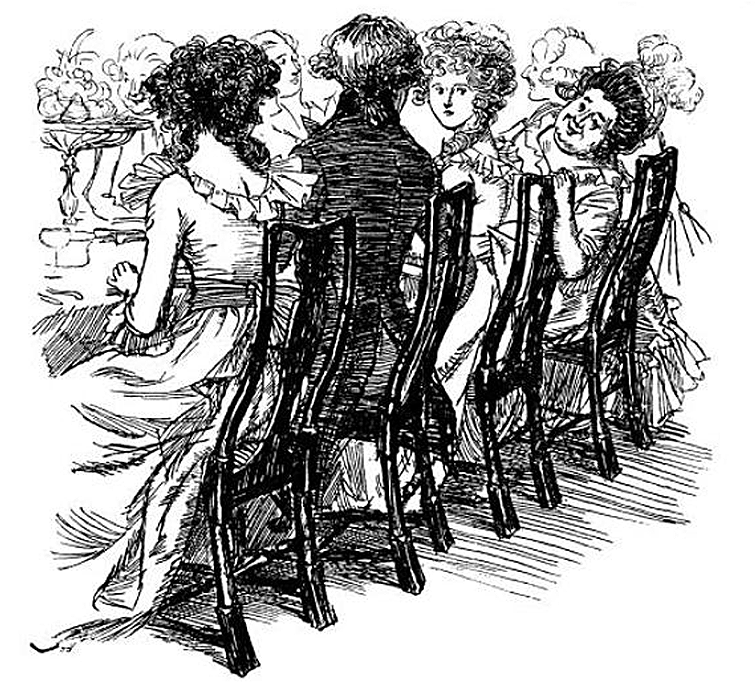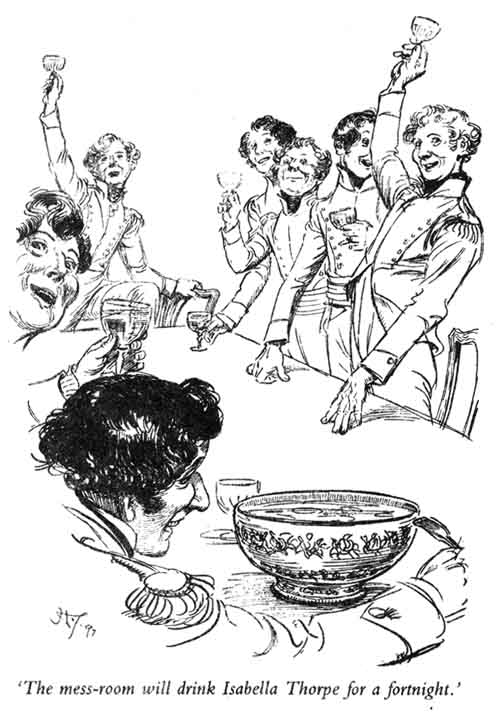
Regency Dinner Parties and Etiquette
"The soup was fifty times better than what we had at the Lucases' last week; and even Mr Darcy acknowledged, that the partridges were remarkably well done; and I suppose he has two or three French cooks at least."
Mrs. Bennet, Pride and Prejudice
 A Regency dinner party was quite an affair encompassing several courses with a multitude of dishes at each. Guests who sat down to eat were faced with soup, meat, game, pickles, jellies, vegetables, custards, puddings- anywhere from five to twenty-five dishes depending on the grandeur of the occasion.
A Regency dinner party was quite an affair encompassing several courses with a multitude of dishes at each. Guests who sat down to eat were faced with soup, meat, game, pickles, jellies, vegetables, custards, puddings- anywhere from five to twenty-five dishes depending on the grandeur of the occasion.
The first course would have been soup, which the host would supervise the serving of. When that was finished and cleared away, he would carve the larger joints of meat (mutton, beef, etc.). The gentlemen of the party would serve themselves from the dishes in front of them, and offer them to their neighbors. If a dish was required from another part of the table, a manservant would be sent to fetch it. Fortunately guests were not expected to try every dish on the table!
 When the main course was cleared a small dessert of salad and cheese was put in its place until that was cleared in favor of the second course, which was a variety much like the first including many dishes savoury and sweet. This, in turn, was cleared, the cloth taken away and Dessert was served- usually nuts, fruits, sweetmeats and perhaps ice cream. At last the ladies would retire to the drawing room to gossip and embroider and chat for about an hour while the gentlemen enjoyed their Port in the dining room. They would then gather for tea and conversation- sometimes cards, and tea again- until the party broke up, quite late in the evening. A period volume, True Politeness: A Handbook of Ettiquette for Ladies offers the following suggestions:
When the main course was cleared a small dessert of salad and cheese was put in its place until that was cleared in favor of the second course, which was a variety much like the first including many dishes savoury and sweet. This, in turn, was cleared, the cloth taken away and Dessert was served- usually nuts, fruits, sweetmeats and perhaps ice cream. At last the ladies would retire to the drawing room to gossip and embroider and chat for about an hour while the gentlemen enjoyed their Port in the dining room. They would then gather for tea and conversation- sometimes cards, and tea again- until the party broke up, quite late in the evening. A period volume, True Politeness: A Handbook of Ettiquette for Ladies offers the following suggestions:
- The hostess takes the head of the table; the seat of honor for a gentleman is at her right hand; for a lady, it is to the right of the host.
- It is usual to commence with soup, which never refuse; if you do not eat is, you can toy with it until it is followed by fish...soup must be eaten from the side, not the point of the spoon; and in eating it, be careful not to make a noise, by strongly inhaling the breath: this habit is excessively vulgar; you cannot eat too quietly.
- Always feed yourself with the fork, a knife is only used as a divider. Use a dessert spoon in eating tarts, puddings, curres, &c., &c.
- If what you are eating before dessert has any liquid, sop the break and then raise it to the mouth.
- The mistress of the household should never appear to pride herself reagarding what is on her table...; it is much better for her to observe silence in this respect, and leave it to her guests to pronounce eulogiums on the dinner.



3 comments
Pauline Trenerry
I love this page! Reading about how life was back then is always so fascinating to me!
Julie
I really like this page, especially the layout of the dishes. Dinner is so different now! Can I use some of the information to put on my Jane Austen blog (www.alljaneausten.wordpress.com)? Thank you.
Anonymous
Leave a comment
This site is protected by hCaptcha and the hCaptcha Privacy Policy and Terms of Service apply.